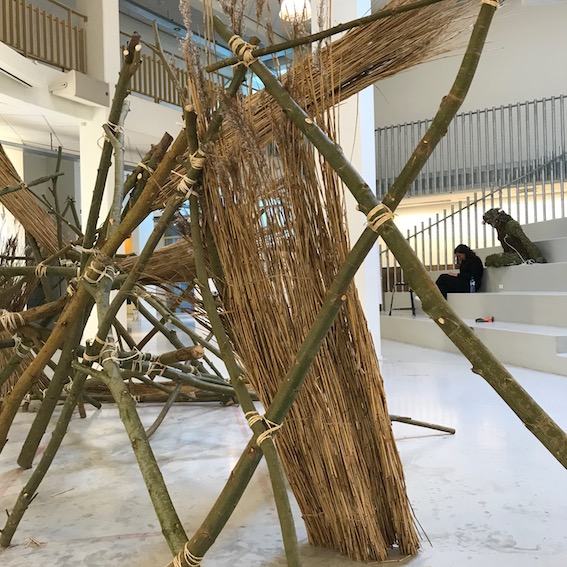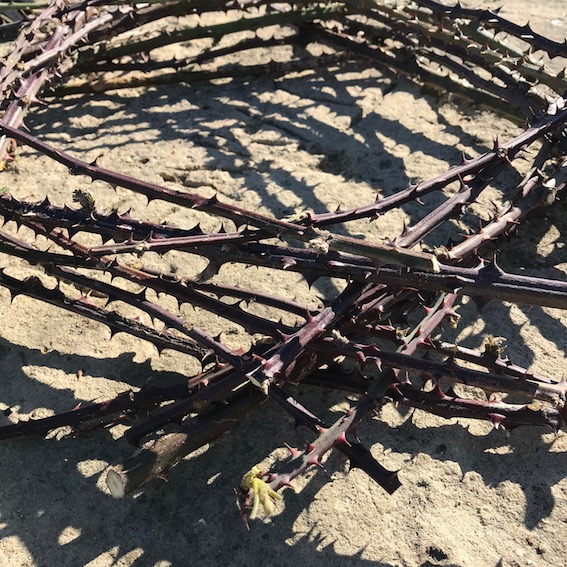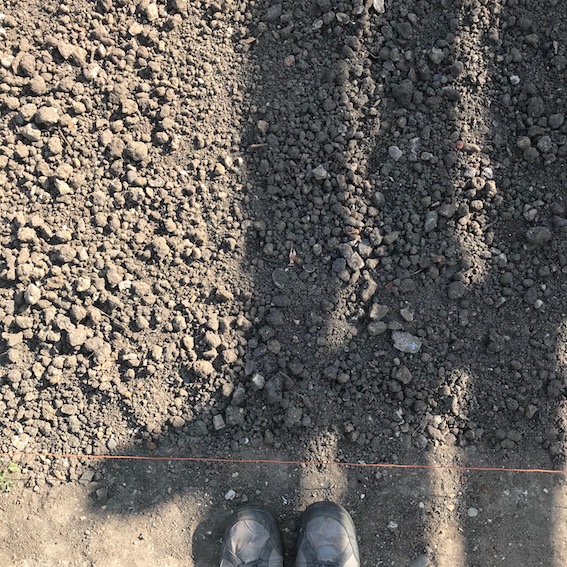24 Apr Scaffolds

Each member of the Crafting the Commons network has been invited to write a post for the blog, capturing their thinking about commons and commoning as the project unfolds. This post is by Shane Waltener.
Shane’s work draws inspiration from craft practice. His ideas are rooted in ecology and reuse. Projects often involve audiences in the making of artworks to facilitate personal, social and cultural histories relating to these crafts to be exchanged. With an interest in dance and movement, and as a member of the Ambient Jam Ensemble, the artist explores means of ‘choreographing making’ through improvisation, score writing and the use of sensory objects, thinking about making as an embodied practice. Shane is an associate lecturer at the University of the Arts, London, a resident artist at Stave Hill Ecological Park and co-author of Practical Basketry Techniques (A&C Black, 2012).
A few months ago I was invited to be artist in residence at Minerva Academie in Groningen, the Netherlands. I didn’t know how I wanted to approach this beyond wanting to do something that would be site responsive and performative and also engaged with architecture in some way. I wanted the group I’d be working with to practice ancient crafts using locally sourced plant materials, something I’ve been doing on my own and with a number of groups at Stave Hill Ecological Park in Rotherhithe for a number of years now.

Going to Groningen on a recce I found out about the earthquakes. The province around the city has experienced 1,400 of them since the early 90s. The cause of it is the mining of natural gas for over 60 years. €2bn profit by Exxon and Shell has meant 100+ buildings have collapsed, 400+ have been condemned and 100,000+ people have been affected and/or displaced since seismic activity began. Issues about reparation and compensation are problematic, ongoing and political.
What has happened in Groningen is symptomatic of the worldwide abusive relationship we have with our environment. This situation in Groningen provided me and the group I worked with, later named the Building Action Group (BAG), a starting narrative for the project. It resonated with my own practice where I’ve been looking and advocating sustainable ways of working, thinking about ecology and means of working more mindfully with plant materials which I now almost exclusively work with. This situation in Groningen is also connected with current research I am doing with artist Eva Sajovic enquiring about the provenance of materials from raw material to product; the relationship between sustainability, making and production; craft as a form of commons; and questioning the role of the artist in a time of ecological, political and social breakdown.
How we use natural resources (and all are natural in the end) frames my thinking with relation the commons. This issue about mineral rights is about land rights and ownership. Who has access to what? How we manage resources, to what end and who for? While in Groningen I experienced an earthquake the same day my mother in Australia who told me she had to move out of her house due to the bushfires. A very strange day indeed! As I talked to her on the phone, she read me an extract from the Statement from the Heart which sheds an interesting light on the idea of ownership being of shared ‘sovereignty’ between peoples and the earth. Here is the extract:
Our Aboriginal and Torres Strait Islander tribes were the first sovereign Nations of the Australian continent and its adjacent islands, and possessed it under our own laws and customs. This our ancestors did, according to the reckoning of our culture, from the Creation, according to the common law from ‘time immemorial’, and according to science more than 60,000 years ago. This sovereignty is a spiritual notion: the ancestral tie between the land, or ‘mother nature’, and the Aboriginal and Torres Strait Islander peoples who were born therefrom, remain attached thereto, and must one day return thither to be united with our ancestors. This link is the basis of the ownership of the soil, or better, of sovereignty. It has never been ceded or extinguished, and co-exists with the sovereignty of the Crown. How could it be otherwise? That peoples possessed a land for sixty millennia and this sacred link disappears from world history in merely the last two hundred years?
With BAG we planned to build a house entirely constructed from locally sourced materials. This as a ‘symbolic act of repair’ rather proposing a model for housing that would sustain seismic activity. We weren’t architects and in any case, many building models already exist. We collected with willow, reeds, hemp, sand and clay to build a number of architectural structures which we found ways of inhabiting in some way. We presented the making of these as performance, using them as props for a number of performative actions in order to bring into mind a new imaginary as to how we might better work with our natural environment, sustain ourselves with and as part of it.


The work with BAG inspired my response to the brief for We Are Commoners. That is wanting to making scaffold structures using willow and brambles, woven and tied together with handmade flax and nettle twine. I am currently growing the flax myself. I plan to harvest nettles for fibre growing locally. The work will be presented as performance. That is the making of the scaffolds, unmaking and rebuilding of these with each instalment of the exhibition. The resulting static installations (scaffolds, also known as staging) will be shown with accompanying filmic, photographic and written records of the making process, ‘instructibles’ (see below) and the performance score itself.


Why scaffolds? Making temporary structures out of plant material that offer potential for support, protection and assist us in maintaining and repairing the physical world around us seems a useful image to work with when thinking about the commons. The planned performance installation is to be seen as ‘a symbolic act of repair’, one that prompts us to rethink our connection with our environment, how we might (re)learn from nature and in doing so, rewrite narratives relating to all of the above.
Since Covid-19 and the present lockdown situation, work at Stave Hill Ecological Park with volunteers and UAL students has come to a halt. I have had to rethink how to develop the work and who would perform it. I’m very much hoping that academics and artists involved in We Are Commoners, and possibly a broader community too, could be the new makers / performers. I’m in the process of putting together resources in the form of written, photographic and video instructibles that would be shared remotely, so elements of the making of the scaffold can be rehearsed and through this process, ideas as well as skills be workshopped and exchanged. The outcome of this exchange would lead to the writing of the performance score, the performance itself and making of the installation.

The first thing I did with BAG was to ask them to write a manifesto. This to firm up on our values and principles and to help guide us through the work we were about to do together. Below is their manifesto. When reading it, imagine replacing ‘BAG’ with ‘Commons’. Could the reading of this manifesto inform our Commons thinking?
The BAG Manifesto
BAG is community
BAG is craft
BAG is care
BAG is sharing
BAG is listening
BAG creates awareness
BAG creates collectiveness
BAG creates inclusion
BAG creates a platform for discussion
BAG celebrates (re)discovering simple principles
BAG celebrates exploring cultural memory
BAG celebrates connecting and reconnecting
BAG celebrates change and ephemerality
BAG celebrates dissensus as well as consensus
BAG stands for withholding uncertainty
BAG stands for empowerment
BAG stands for integrity
Extracts of some of the literature BAG and I shared at the start of the project. I’ll be using this as reference points when developing the project with participants for We Are Commoners:
‘On so many levels, craft is about care. Care is something we could all do with more of today’. – Jenny King
Olafur Eliasson: ‘Josefine, you are able to put into words things that are otherwise difficult to articulate – to give a voice to things experience largely through the senses. I’d like to begin with something from the talk you gave a month ago in defence of the Amager nature reserve, a talk that was later printed in the Danish newspaper Politiken. It was tremendous! In it, you emphasise values associated with nature as being held in common – you don’t utilise the traditional split into subject and object, or the idea that nature resides outside of us while culture resides within us as human beings. The nature reserve is a large, still undeveloped green space in Copenhagen that, unsurprisingly, investors and politicians have been trying to develop for a long time. It hosts a variety of flora and fauna, and the human presence has also established itself amid the plant and animal life. Copenhageners use the Amager nature reserve as an extension of themselves, and that, I think, is very exciting, for that’s just how I have always used Iceland. Maybe we could start by talking about your vision of nature.’
Josefine Klougart: ‘The talk dealt with why I think it’s a bad idea to build upon a common natural space like the reserves, and it took as its starting point the description of a fantasy that I think is central to the problems we are facing today, both as individuals and as a society or culture, both locally and globally; the fallacy that it makes sense to draw a distinction between people and nature is something radically other, something located ‘out there’, something for us to investigate and observe. I think this is an illusion – an illusion that prevents us from experiencing ourselves as existing in an intimate connection with all life, as being part of all life, and illusion that paves the way for an instrumental relation to nature in and around us. (…) Our cultural history is the history of nature itself thinking, of nature itself trying to understand the world – in the words of poet Inge Christensen, ‘nature’s effort to understand itself’. Rather than seeing culture as an indication of the distinction between humanity and nature, we need to see it as the manifestation of an intimate connection. When we speak, we are nature speaking; when we think, we are nature thinking; when we control nature outside us, we are nature controlling something within itself.’
‘If a forest is chopped down to build a factory, only the economic benefit is counted ; no negative value is attributed to the destruction of the environment (…) ecological economists have tried to model the monetary value of the planet on similar economic terms: ‘intangible capital’ they call it. ‘What is the price of things as subjective as the ocean’s aesthetic, artistic, educational, spiritual and scientific benefits?’ (David) Pilling wonders. It’s a good question. Perhaps we shouldn’t answer it with a number.’ – Paul Teasdale
FREESPACE describes a generosity of spirit and a sense of humanity at the core of architecture’s agenda, focusing on the quality of space itself.
FREESPACE focuses on architecture’s ability to provide free and additional spatial gifts to those who use it and on its ability to address the unspoken wishes of strangers.
FREESPACE celebrates architecture’s capacity to find additional and unexpected generosity in each project – even within the most private, defensive, exclusive or commercially restricted conditions.
FREESPACE provides the opportunity to emphasise nature’s free gifts of light – sunlight and moonlight; air; gravity; materials – natural or man-made resources.
FREESPACE encourages reviewing ways of thinking, new ways of setting the world, of inventing solutions where architecture provides for the well-being and dignity of each citizen of this fragile planet.
FREESPACE can be a space for opportunity, a democratic space, un-programmed and free for uses not yet conceived. There is an exchange that happens between people and buildings, even if not intended or designed, so buildings themselves find ways of sharing and engaging with people over time, long after the architect has left the scene. Architecture has an active as well as a passive life.
FREESPACE encompasses freedom to imagine the free space of time and memory, binding past, present and future together, building on inherited cultural layers, weaving the archaic with the contemporary.
– Yvonne Farrell & Shelley McNamara
‘To keep our promises, to be the people we said we were, to stage what we know in the stillness hour of the night to be true, to remind ourselves of the impossible, the historical, to choreograph a dance to repair the world, to say ‘We have become human again.’ – Goat Island
‘Small acts of repair. Calming the hands in a troubled world. Restoring damage to renewed use’ – Goat Island from ‘Small Acts of Repair: Performance, Ecology, and Goat Island’
‘I am I plus my surroundings and if I do not preserve the latter, I do not preserve myself.’ – Jose Ortega Y Gasset
‘An object means nothing unless it is a tool for interaction.’ – Lygia Clark
‘Sculpture is not enough, it requires a gesture’ – Giuseppe Penone
‘Knowing is not enough. We must apply. Willing is not enough. We must do.’ – Goethe
‘Simplicity of shape does necessarily equate with simplicity of experience.’ – Robert Morris
‘Think with the whole body.’ – Deshimaru

